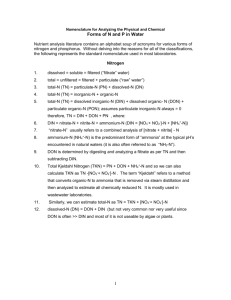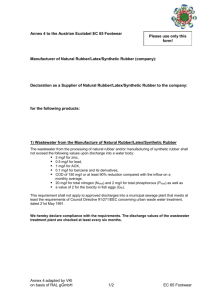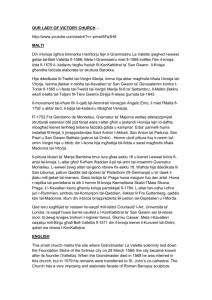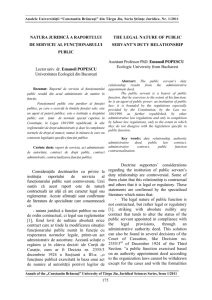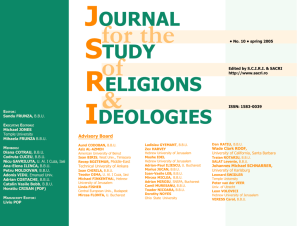Scenariu în limba română
advertisement
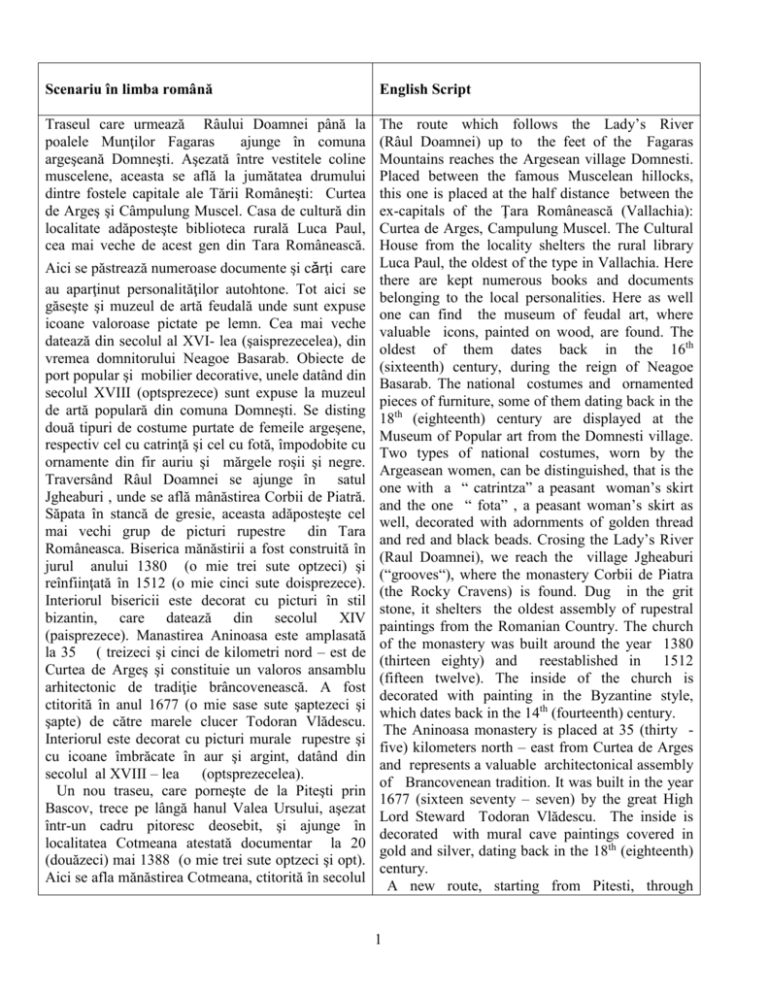
Scenariu în limba română English Script Traseul care urmează Râului Doamnei până la poalele Munţilor Fagaras ajunge în comuna argeşeană Domneşti. Aşezată între vestitele coline muscelene, aceasta se află la jumătatea drumului dintre fostele capitale ale Tării Româneşti: Curtea de Argeş şi Câmpulung Muscel. Casa de cultură din localitate adăposteşte biblioteca rurală Luca Paul, cea mai veche de acest gen din Tara Românească. The route which follows the Lady’s River (Râul Doamnei) up to the feet of the Fagaras Mountains reaches the Argesean village Domnesti. Placed between the famous Muscelean hillocks, this one is placed at the half distance between the ex-capitals of the Ţara Românească (Vallachia): Curtea de Arges, Campulung Muscel. The Cultural House from the locality shelters the rural library Luca Paul, the oldest of the type in Vallachia. Here there are kept numerous books and documents belonging to the local personalities. Here as well one can find the museum of feudal art, where valuable icons, painted on wood, are found. The oldest of them dates back in the 16th (sixteenth) century, during the reign of Neagoe Basarab. The national costumes and ornamented pieces of furniture, some of them dating back in the 18th (eighteenth) century are displayed at the Museum of Popular art from the Domnesti village. Two types of national costumes, worn by the Argeasean women, can be distinguished, that is the one with a “ catrintza” a peasant woman’s skirt and the one “ fota” , a peasant woman’s skirt as well, decorated with adornments of golden thread and red and black beads. Crosing the Lady’s River (Raul Doamnei), we reach the village Jgheaburi (“grooves“), where the monastery Corbii de Piatra (the Rocky Cravens) is found. Dug in the grit stone, it shelters the oldest assembly of rupestral paintings from the Romanian Country. The church of the monastery was built around the year 1380 (thirteen eighty) and reestablished in 1512 (fifteen twelve). The inside of the church is decorated with painting in the Byzantine style, which dates back in the 14th (fourteenth) century. The Aninoasa monastery is placed at 35 (thirty five) kilometers north – east from Curtea de Arges and represents a valuable architectonical assembly of Brancovenean tradition. It was built in the year 1677 (sixteen seventy – seven) by the great High Lord Steward Todoran Vlădescu. The inside is decorated with mural cave paintings covered in gold and silver, dating back in the 18th (eighteenth) century. A new route, starting from Pitesti, through Aici se păstrează numeroase documente şi cǎrţi care au aparţinut personalităţilor autohtone. Tot aici se găseşte şi muzeul de artă feudală unde sunt expuse icoane valoroase pictate pe lemn. Cea mai veche datează din secolul al XVI- lea (şaisprezecelea), din vremea domnitorului Neagoe Basarab. Obiecte de port popular şi mobilier decorative, unele datând din secolul XVIII (optsprezece) sunt expuse la muzeul de artă populară din comuna Domneşti. Se disting două tipuri de costume purtate de femeile argeşene, respectiv cel cu catrinţă şi cel cu fotă, împodobite cu ornamente din fir auriu şi mărgele roşii şi negre. Traversând Râul Doamnei se ajunge în satul Jgheaburi , unde se află mânăstirea Corbii de Piatră. Săpata în stancă de gresie, aceasta adăposteşte cel mai vechi grup de picturi rupestre din Tara Româneasca. Biserica mănăstirii a fost construită în jurul anului 1380 (o mie trei sute optzeci) şi reînfiinţată în 1512 (o mie cinci sute doisprezece). Interiorul bisericii este decorat cu picturi în stil bizantin, care datează din secolul XIV (paisprezece). Manastirea Aninoasa este amplasată la 35 ( treizeci şi cinci de kilometri nord – est de Curtea de Argeş şi constituie un valoros ansamblu arhitectonic de tradiţie brâncovenească. A fost ctitorită în anul 1677 (o mie sase sute şaptezeci şi şapte) de către marele clucer Todoran Vlădescu. Interiorul este decorat cu picturi murale rupestre şi cu icoane îmbrăcate în aur şi argint, datând din secolul al XVIII – lea (optsprezecelea). Un nou traseu, care porneşte de la Piteşti prin Bascov, trece pe lângă hanul Valea Ursului, aşezat într-un cadru pitoresc deosebit, şi ajunge în localitatea Cotmeana atestată documentar la 20 (douăzeci) mai 1388 (o mie trei sute optzeci şi opt). Aici se afla mănăstirea Cotmeana, ctitorită în secolul 1 XIV (paisprezece) de către domnitorul Radu I, şi de fiii săi, Dan I şi Mircea cel Bătrân. Este un monument reprezentativ pentru perioada de dezvoltare a arhitecturii munteneşti. Biserica mănăstirii este construită din cărămidă şi decorată în exterior cu o succesiune de firide, marcate prin discuri de ceramică smălţuită. Cupola, catapeteasma şi pereţii interiori ai bisericii vechi din cadrul complexului monahal Cotmeana sunt acoperiţi cu fresce murale în stil bizantin, cele mai multe fiind originale. În ultimii ani, în cadrul mânăstirii s-au construit o biserică nouă, o trapeză şi chilii moderne. Pornind spre sudul judeţului, spre Slatina, drumul care străbate lunca Teleormanului ajunge în oraşul Costesti, situat la 34 (treizeci şi patru) de kilometri de capitala judeţului. Are o populaţie de circa 11.000 (unsprezece mii) de locuitori şi este cunoscut pentru Festivalul popular Narcisa de Aur, organizat anual în luna mai. Impozanta biserică din Costesti a fost construită în secolul al XIX – lea (nouăsprezecelea) şi se particularizează prin dantela de piatră care înconjoară ferestrele înguste şi prin frescele pictate în partea superioară a faţadei. În comuna Izvoru se află conacul familiei Petricari – Davilla, amplasat într-un frumos parc, creat la sfârşitul secolului al XIX – lea (nouăsprezecelea). La o distanţă de 64 (şaizeci şi patru) kilometri sud est de Piteşti, pe o colină din apropierea comunei Ştefan cel Mare este amplasată mânăstirea Glavacioc, citată documentar în anul 1441 (o mie patru sute patruzeci şi unu). Biserica de mir a mânăstirii Glavacioc şi chiliile construite în secolul al XVI – lea (şaisprezecelea) păstrează elemente arhitecturale specifice epocii brâncoveneşti. Interiorul mânăstirii Glavacioc, împodobit cu fresce murale, adăposteşte icoana făcătoare de minuni a Maicii Domnului şi numeroase piese sculptate în lemn şi piatră, între care lespedea de mormânt a voievodului Vlad Călugărul. Pornind din Piteşti spre sud – vestul judeţului Argeş, drumul ajunge în localitatea Lunca Corbului, şi de aici la Stolnici, comuna în care se află conacul familiei Bălăceanu , construit la începutul secolului al XIX – lea (nouăsprezecelea). Biserica, zidul de incinta şi anexele, care fac parte din ansamblu au fost declarate monumente istorice şi incluse în patrimoniul naţional cultural. Familia Bălăceanu a jucat un rol important în istoria Tarii Romaneşti în epoca feudală şi cea modernă. La Stolnici, Lunca Bascov, passes next to the Valea Ursului Inn, placed in a special picturesque frame, and reaches the locality of Cotmeana, first mentioned in the historical documents on the 20th (twentieth) of May, 1388 (thirteen eighty – eight). Here, the Cotmeana monastery is found, built in the 14th (fourteenth) century by the ruler Radu I, and his sons, Dan I and Mircea the Old. It is a representative monument for the Muntenean architecture developing period. The church of the monastery is made of brick and it is decorated on the outside by successive niches, marked by stoneware discs. The dome, the anti – screen and the inner walls of the old church from the monarchal complex of Cotmeana are covered by mural frescos in a Byzantine style, most of them being original. Over the last years, within the monastery there have been built a new church, a refectory and modern cells. Starting towards the south of the county, to Slatina, the road which crosses the meadow of Teleorman reaches Costesti, situated at 34 (thirty four) kilometers from the county capital. It has a population of about 11,000 (eleven thousand) inhabitants and it is well known for the Folk Festival The Golden Daffodil, organized yearly in the month of May. The impressive church from Costesti, was built in the 19th (nineteenth) century and it is characterized by stone lacey which surrounds the narrow windows and through the painted frescos in the upper part of the front side. In the Izvoru (“spring“) village we can find the mansion of Petricari – Davilla family, placed in a beautiful park, created at the end of the 19th (nineteenth) century. At a distance of 64 (sixty four) kilometers south - east from Pitesti, on a hillock near the village of Stefan cel Mare (Stephan the Great), the Glavacioc monastery is placed, first mentioned in a historical document in the year 1441 (fourteen forty – one), the holly church of the Glavacioc monastery and the cells built in the 16th (sixteenth) century keep architectural elements specific to the Brancoveanu age. The inside of the Glavacioc monastery, adorned with mural frescos, shelters the wonder maker holly icon of the Mother of God and numerous items carved in wood and stone, among which the tomb stone of the ruler Vlad Calugarul (Vlad - the Monk ). Heading from Pitesti towards the south – west 2 Corbului şi Marghia, portul şi dansul popular sunt ţinute la loc de cinste. Căluşul, jocul popular naţional al românilor, are aici tradiţii vechi. De la Stolnici, prin Hârseşti, se ajunge la Bârla, unde se află staţiunea balneo – climaterica Bădeşti, una dintre cele mai importante de acest fel din regiune. Aici se încheie scurta călătorie virtuală prin judeţul Argeş, care îşi aşteaptă vizitatorii cu tradiţionala ospitalitate românească. of the Arges county, the road riches in the locality of lunca Corbului (The Meadow of the Raven), and from here on to Stolnici, the village where we can find the mansion of the Balaceanu family, built at the beginning of the 19th ( nineteenth ) century. The church, the inside wall and its enclosures, which are part of the assembly have been declared historical monuments and included in the national cultural thesaurus. The Balaceanu family played an important part in the history of Vallachia during the feudal and modern era. At Stolnici, Lunca corbului and Marghia, the national costumes and the national dance are very important. Calusul, Romanians national dance, has its ancient roots in here. From Stolnici, through Harsesti, we reach to Barla, where the water resort of Badesti can be found, one of the most important of the kind in this region. Here ends our short virtual journey through Arges county, which awaits it visitors with their well known traditional Romanian hospitability. 3

